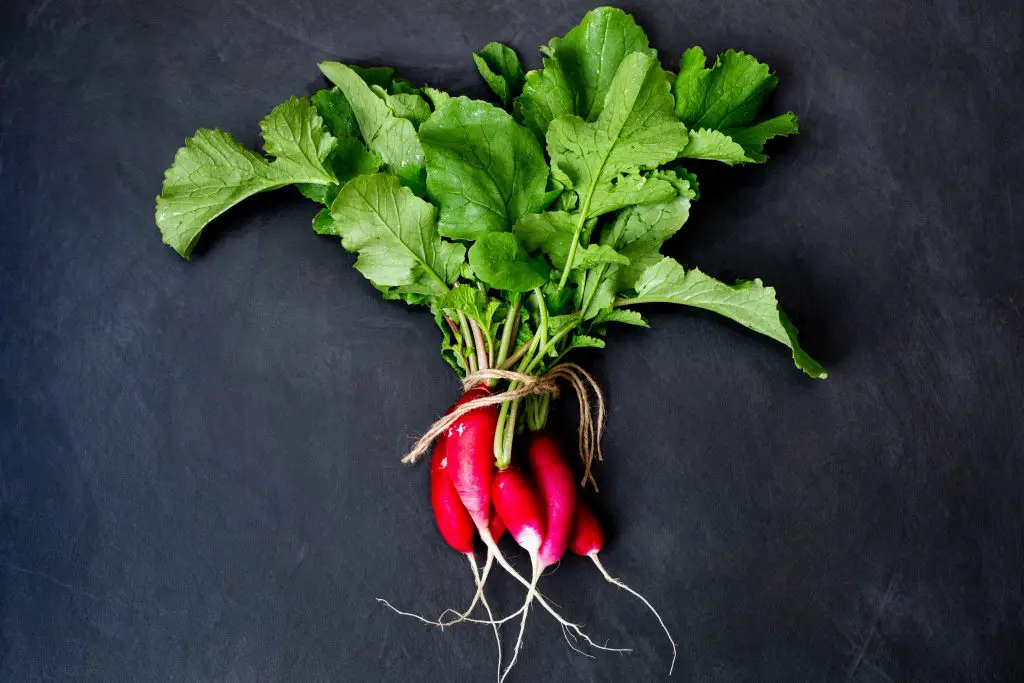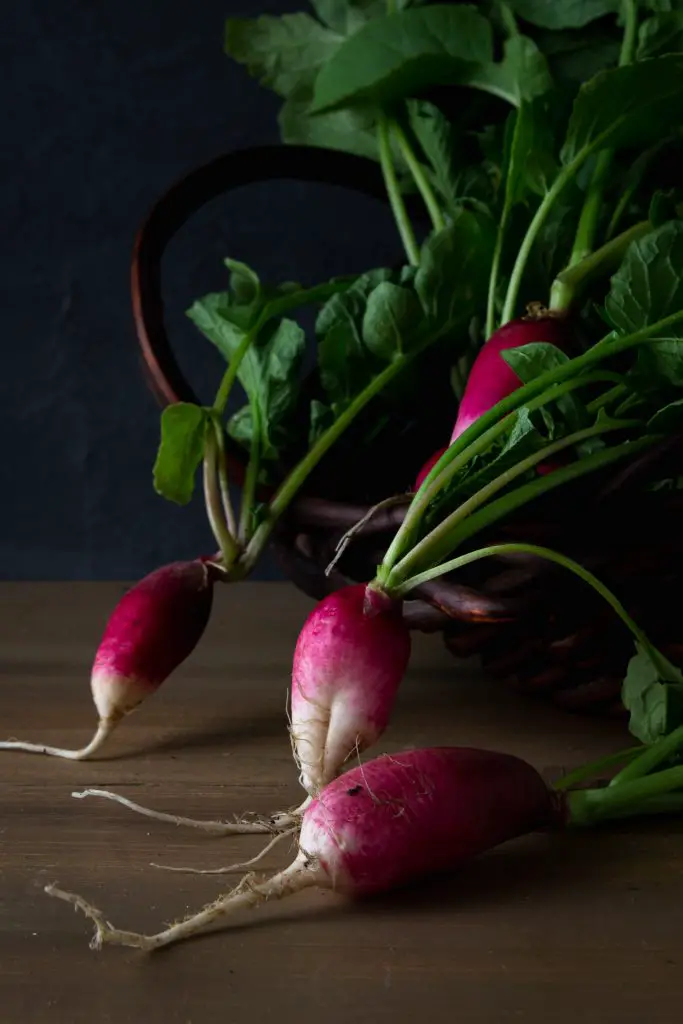Are Radishes and Turnips The Same? Turnips and Radishes are commonly grown vegetables that are popular in European cuisine. At first glance, they appear to be similar as both are root crops that have white flesh that is covered in skin that is sometimes red or partly red, though not all radish varieties have red skin. So are Radishes and Turnips just different names for the same thing?
Radishes and Turnips are separate species that both belong to the brassica family which includes broccoli cauliflower and kale. Radishes are crunchy, have a spicy peppery flavor, and grow extremely rapidly, but they also have an extremely limited self-life. Whereas turnips have a much milder flavor and are grow over several months and generally store well during the winter months of the year.
Additionally, Turnips are generally much larger than radishes with diameters that are typically 2 to 8 inches in wide whereas radishes are much smaller in size, typically only one inch in diameter. Radishes are also available in a range of colors which include black and white-skinned varieties that are not always round or oval in shape.

The Differences Between Turnips And Radishes
While turnips and radishes are from the same family, brassicas, they come from two separate genera which means that turnips are more closely related to vegetables such as broccoli, cauliflower, and kale than radishes, which seems strange given the apparent physical similarities. So what are the differences?
Color
Turnips have generally have red or purple shoulders that appear above the ground while the lower section of the root that is below the ground is white. Whereas Radishes have largely the same skin color irrespective of whether the root has grown above or below the ground.
Size
Turnips are generally much larger in size than radishes typically weighing 2 to 3 pounds, whereas most radishes sold commercially only weigh a few ounces. However, it is important to note that sizes sold commercially in major grocery stores represent only a small percentage of the available types of turnips and radishes.
It is possible to produce much larger radishes either by selecting less common varieties or by simply allowing the plant to grow longer.
Taste
As mentioned above turnips have a much milder flavor than radishes, which tend to have a sharp peppery taste. However, the flavor of turnips tends to become more pronounced as the vegetable gets older.
Grow Rate
Radishes are renowned as being extremely rapid croppers that can be picked in a matter of only 4 weeks, however I personally found that the growth rate is a little slower than that. Whereas turnips have a much slower growth rate that is typically several months rather than several weeks if they are allowed to fully develop.
However, the growing time can be shortened if the turnips are picked when they are extremely young as babies. In these cases, a golf ball-sized turnip can be grown in 5 to 8 weeks. Given that this is a similar size to radishes it tells you that the growth rate of the 2 vegetables is not all that different.
Storage
As mentioned above Turnips that are grown to full maturity will generally store well for several months if they are kept in a cool dark location. As a general rule the larger the root the longer it will store. Turnips generally do not store as well as swedes or potatoes and should be eaten first.
Whereas radishes are relatively perishable and will typically only last in a fridge for approximately ten days before becoming soft.

Nutrition
Both Turnips and Radishes are generally considered to be healthy foods though Radishes did receive a higher score on versus.com. Radishes have around half the amount of sugar of turnips and elevated levels of vitamin K, folate, and iron which are highly beneficial to the body. However, either vegetable would be considered suitable for diabetics as the carbohydrate levels are extremely low.
Growing Radishes
Growing radishes is extremely quick and easy with it being possible to produce a crop from seed in a few weeks. Due to this relatively fast growth rate radishes are often sown between other crops that produce crops much more slowly. An example of this is when sown they with on top of carrot seeds. This can be done because Radishes do not interfere with the carrots because they are harvested when the carrots are little more than a tiny seedling.
Radishes can germinate in soil at temperatures as low as 40°F (4°C) with seedlings appearing 5 to 7 days later. The seeds can be sown directly into soil however if you are wanting to start them off early in the season when the temperatures are still really cold it is advisable to sow them in seed trays.
Seeds should be sown at a depth of approximately 0.5 inches (1 cm), with the traditional approach being to sow the seeds individually. However, an alternative approach that I have found extremely effective is to sow the seeds in clumps of 5.
This technique, known as multi-sowing, has several advantages. The first is that there is a greater number of seeds that can be sown in a single seed tray. The second key advantage is that it is much faster to transplant the seedlings out into the garden as you are effectively planting 5 at a time.
After a week or 2, the radishes will be ready to plant out into the garden. As the plants are tolerant of frost they can be planted out into the garden at any stage when the daytime temperatures are greater than 40°F (4°C). If you are planting them individually they should be typically spaced approximately 1 to 2 inches apart. If they are in clumps a spacing of 4 to 5 inches is recommended.
In terms of location, radishes prefer a sunny location but they will also tolerate shady spots in the garden. Ideally, radishes prefer rich moist soil that is well-drained. Due to their rapid growth, they do not require much maintenance apart from ensuring that the soil remains moist by regularly watering the plants.
The radishes can be picked at any stage once the roots reach a size that is greater than 0.5 inches in diameter, however, they will hold in the garden for a few weeks provided that the temperatures are not too high. It is best to pick them just before you eat them as they will not store for long.
If they are left in the garden too long they will run to seed which is not all bad as the green seed pods make an excellent snack with beer.

Growing Turnips
Unlike Radishes, Turnips take several months to reach full size and they are commonly used as a winter vegetable as they store quite well. To take advantage of these properties Turnips are most commonly sown from early spring to mid-summer which allows the turnip to reach a reasonable size before the winter hits.
The seeds can be sown directly into the garden but I recommend sowing them in trays. The reason for this is that it reduces the time spent in the garden allowing other things to be grown.
The seeds should be sown at a depth of 0.5 inches in seed raising mixture. Like the radish seeds, they can be sown individually or in clumps of 4 to 6 seeds. The seedling will take 7 to 14 days to emerge and will typically need to spend a further 4 weeks in the seed trays before they are large enough to plant outside in the garden.
The seedlings should be spaced approximately 10 inches apart which might seem excessive however when the additional distance will enable a dutch hoe to be used to remove weeds. This reduces the level of maintenance required.
In terms of location and soil conditions. Turnips prefer similar growing conditions to the radishes and will also tolerate full sun and partially shaded locations within the garden. Turnips also require little ongoing maintenance apart from regular watering.
As they are a frost-tolerant vegetable they can be left for an extended period of time in the garden and picked at any stage when required. However, the smaller younger turnips tend to be sweeter than the older ones which can become slightly bitter and peppery over time.
If the turnips need to be picked they will store reasonably well for a period of 3 to 4 months provided that they are stored in a cool dark location.
